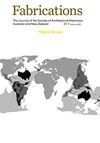Inconvenient Truths: Framing an Architectural History for Cold War Australia
IF 0.2
0 ARCHITECTURE
Fabrications-The Journal of the Society of Architectural Historians Australia and New Zealand
Pub Date : 2021-05-04
DOI:10.1080/10331867.2021.1930751
引用次数: 0
Abstract
ABSTRACT To date, Australia’s architectural histories have been silent on the Cold War politics of post-war modernism. For the most part, historians have documented production without considering the broader geo-political moment in which the nation found itself after World War II. Recent transnational architectural histories focus on relationships that the United States and the former USSR forged between themselves and individually with other countries. In so doing, canonical accounts of post-war modernism have been brought into question and architectural practice implicated in broader global shifts of power, economy, and control. Some historians have concentrated on transatlantic connections, others have drawn peripheral modernisms into relief as a series of successive colonial modernisms. This paper explores aspects of Australia’s post-war architectural production that might be regarded as inconvenient truths and implicated in a larger strategic geo-political and economic project. It suggests that the Cold War drew a net across Australia’s entire landscape – urban and remote, seen and unseen. Australia was a willing collaborator. Under the auspices of post-war recovery and with a new-found purpose in the region, projects of extraction, energy, defence, and diplomacy ‘rebuilt’ the nation with a labour force contingent on migration - and architectural modernism was intrinsic to that project.《难以忽视的真相:构筑冷战时期澳大利亚建筑史》
摘要迄今为止,澳大利亚的建筑史一直对战后现代主义的冷战政治保持沉默。在大多数情况下,历史学家在记录生产时没有考虑二战后这个国家所处的更广泛的地缘政治时刻。最近的跨国建筑史关注的是美国和前苏联之间以及各自与其他国家之间建立的关系。在这样做的过程中,战后现代主义的经典描述受到了质疑,建筑实践也与更广泛的全球权力、经济和控制的转变有关。一些历史学家专注于跨大西洋的联系,另一些历史学家则将边缘现代主义作为一系列连续的殖民现代主义加以缓解。本文探讨了澳大利亚战后建筑生产的一些方面,这些方面可能被视为不方便的事实,并与一个更大的战略性地缘政治和经济项目有关。这表明,冷战在澳大利亚的整个版图上拉网——城市和偏远,看得见的和看不见的。澳大利亚是一个愿意合作的国家。在战后复苏的支持下,为了在该地区找到新的目标,开采、能源、国防和外交项目用取决于移民的劳动力“重建”了国家,而建筑现代主义是该项目的内在特征。
本文章由计算机程序翻译,如有差异,请以英文原文为准。
求助全文
约1分钟内获得全文
求助全文
来源期刊

CiteScore
0.50
自引率
25.00%
发文量
26
 求助内容:
求助内容: 应助结果提醒方式:
应助结果提醒方式:


